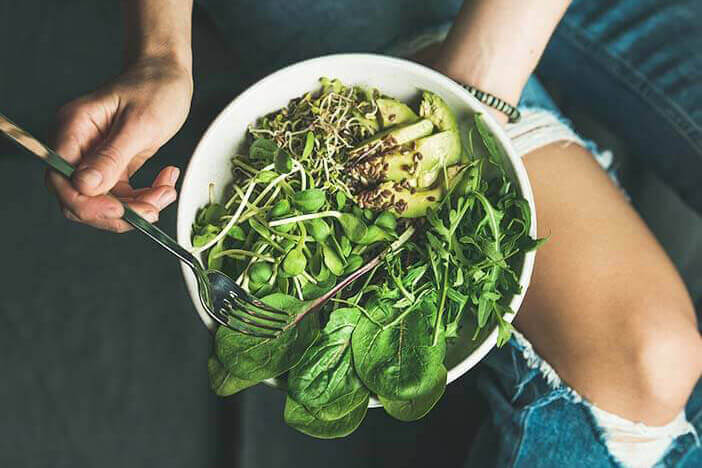Upfit in everyday life - this is how Upfit makes your life easier

Introduction
Get to know two typical people who used Upfit to change their diet and become healthier in the long term while also saving time and money. First read the outline of their life situations and individual nutrition plan settings, then take a look at how they incorporate Upfit into their everyday life.
Personality overview
Nicole (43 years)

Goal: Weight loss
Diet: Vegetarian
Intolerance: Lactose
Weekly exercise activity: 1 x per week
Doesn’t like: Cabbage or celery
Info: Works part-time, likes to snack
Program: 3 months weight loss + work out plan
Goals: Lose 9 kg, get fitter, make healthy eating a long-term habit
Phillip (24 years)

Goal: Muscle building
Diet: “Normal”
Intolerances: None
Weekly exercise activity: 3-4 times per week
Doesn’t like: Fish
Info: Student, irregular daily routine
Program: 6 months of muscle building
Goals: Gain 5 kg (preferably high-quality muscle mass), stay fit, and get the most out of the workout plan
Nicole and Upfit
Nicole's situation and nutrition plan settings in detail
- Age: 43
- Height: 168cm
- Weight: 73 kg
- Goal weight: 65kg
- Plan: 3 months of weight loss + workout plan (at home)
- Activity level: 55 (medium)
- Everyday work-life: Works half days and has a regular daily routine
- Diet: Vegetarian
- Meals: 3 meals per day + 2 snacks
- Cooks: In the evening
- Meal prep: No
- Shopping: Premium quality
- Intolerances/allergies: Lactose intolerant
Motivation: Nicole has tried many diets, but has always succumbed to the yo-yo effect and gained back all the weight she lost. She wants to finally get rid of her love handles for good and change her diet permanently.
Nicole's daily routine
Mornings
- 7:00 a.m. .: Nicole gets up and makes a quick breakfast that does not involve cooking (shakes, smoothies, muesli).
- Since she doesn’t have much time in the morning, she indicated that she can’t cook in the morning – only in the evening.
Late morning
- 10:00 a.m.: At work, Nicole eats a small fruit snack in between breakfast and lunch. To prevent food cravings, Nicole selected 3 meals + 2 snacks – one in the morning and one in the afternoon.
Noon
- 12:00 p.m.: Nicole has prepared a quick, cold meal for her lunch break (salad, wrap, sandwich).
Afternoon
- 3:30 p.m.: After work, Nicole has her second snack.
- 4:00 p.m.: She plans through the entire week and uses the meal swapping feature (which allows her to replace the proposed meal with 1 out of 3 optimized alternatives) to put together her perfect week. The shopping list adapts to her selected meals. Since Nicole doesn’t always want to look up recipes or the shopping list online, she prints out the plan as a PDF and hangs it on the fridge.
- 5:00 p.m.: Nicole then goes shopping for the entire week with the printed shopping list.
Evening
- 6:00 p.m.: After shopping, she cooks her dinner.
- She has a question about the preparation of the meal so she quickly asks our expert in the live online chat – where her question is answered directly.
- Nicole really likes the meal and marks it as a favorite meal with the heart symbol. Thus, the recipe is suggested to her more often or shown as an alternative.
- 7:30 p.m.: Nicole does the exercises from her workout plan for home on Tuesday and Thursday (30 min. whole-body training)
A week later: Unfortunately, Nicole catches the flu and cannot follow her plan for a week. She uses the freeze function and pauses the plan for a week. Then she continues where she left off before the illness.
Phillip and Upfit
Phillips life situation and nutrition plan settings in detail
- Age: 24 years
- Height: 183cm
- Weight: 80kg
- Goal weight: 85kg
- Body fat percentage: 15%
- Plan: 6 months of muscle building
- Activity level: 80 (high)
- Everyday work: Stressful, irregular everyday life. Phillip is a student and has an evening job in a bar
- Weekly exercise activity: 3-4x a week
- Amount of sleep per night: 6-7 hours
- Meals: 3 meals per day
- Cooks: Morning + meal prep
- Shopping: Budget
- Intolerances/allergies: None
- Doesn’t like: Fish or seafood
- Dietary supplements: Yes
Motivation: Phillip would like to be fitter and build muscle. However, he is often stressed and little time in everyday life. Therefore, he wants a strictly outlined, individual plan so that he can use his time more effectively to support him in building muscle and strength training better.
Phillip's daily routine
Mornings
- 9:30 a.m:: Phillip gets up relatively late and has a large breakfast (eggs, omelets, pancakes). He knows that his girlfriend is having breakfast at his place tomorrow, so he adds an extra portion to tomorrow’s breakfast settings his shopping list adjusts accordingly. So later he can buy the right amounts of ingredients for breakfast for two.
Early afternoon
- 1:00 p.m.: At noon he warms up his pre-cooked meal whilst at university.
Late afternoon
- 3:00 p.m..: After uni, Phillip goes to the gym.
- He drinks a protein shake after his workout.
Evening
- 5:00 p.m.: He has no time to go home before work. He skips the Upfit meal and eats out.
- 6:00 p.m.: On the way to work, he would like to go shopping quickly. Unfortunately, he only has his sports bag with him and can therefore only transport a small amount of food. That is why he uses the “Shop by the day” function on his phone and selects the next day. The shopping list adapts automatically and shows only the groceries needed for tomorrow and Phillip can shop in a relaxed spontaneous manner.
- Since he knows that he wants to work out longer tomorrow, he looks at the menu again for tomorrow and based on the macronutrient information replaces the lunch with a protein-rich meal from the alternative meals.
- In the supermarket, he conveniently checks off the groceries on his smartphone one by one until they are all in the shopping bag.
Two weeks later: Phillip would like to go on vacation and knows that he cannot stick to the plan there. He uses the “pause” function and thus stops the plan for a week. After the vacation, he can just carry on from where he left off.


